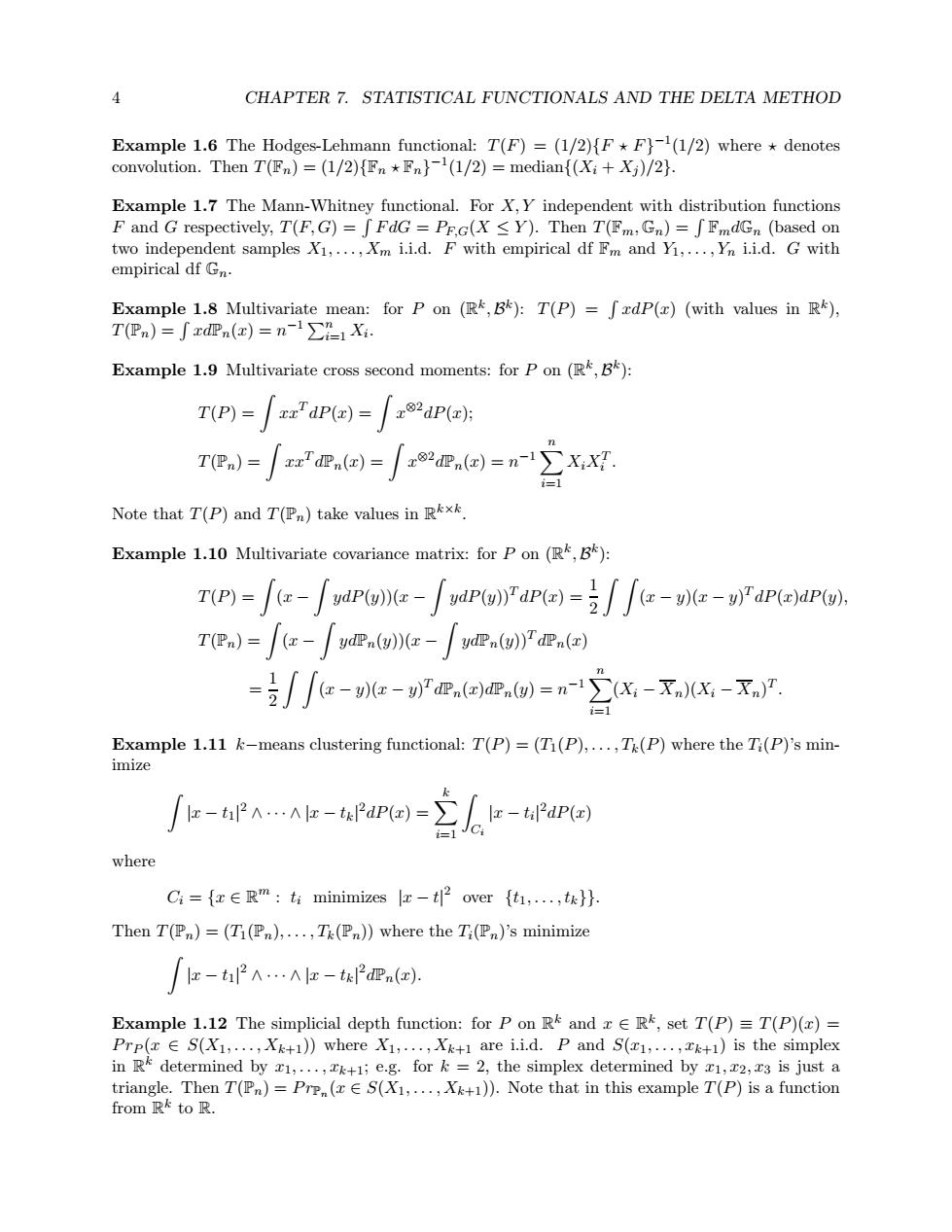正在加载图片...

4 CHAPTER 7.STATISTICAL FUNCTIONALS AND THE DELTA METHOD Example 1.6 The Hodges-Lehmann functional:T(F)=(1/2){FF)1(1/2)where denotes convolution.Then T(Fn)=(1/2){Fn *Fn(1/2)=median{(Xi+Xi)/2}. Example 1.7 The Mann-Whitney functional.For X,Y independent with distribution functions F and G respectively,T(F,G)=fFdG PEG(X <Y).Then T(Fm,Gn)=fFmdGn (based on two independent samples X1,...,Xm i.i.d.F with empirical df Fm and Yi,...,Yn i.i.d.G with empirical df Gn. Example 1.8 Multivariate mean:for P on (R,B):T(P)=fxdP(x)(with values in R), T(Pn)=∫xdPn(o)=n-1∑=1X Example 1.9 Multivariate cross second moments:for P on (R,B): T(P)=zxTdP(x)=22dP(x); T) 「xn'l回)=2n)=n-∑X,Xg Note that T(P)and T(Pn)take values in Rxk. Example 1.10 Multivariate covariance matrix:for P on(R,B) =∫e-兆-P.a2.o)=m-空-不x- Example 1.11 k-means clustering functional:T(P)=(T1(P),...,T(P)where the Ti(P)'s min- imize -ti2dP(x) where Ci=fx E Rm ti minimizes I-t over {t1,...,t}} Then T(Pn)=(Ti(Pn),...,Tk(Pn))where the Ti(Pn)'s minimize -tl-tdn(). Example 1.12 The simplicial depth function:for P on R and z E R,set T(P)=T(P)(x)= Prp(x E S(X1,...,Xk+1))where X1,...,Xk+1 are i.i.d.P and S(1,...,k+1)is the simplex in R determined by x1,...,k+1;e.g.for k =2,the simplex determined by 1,x2,x3 is just a triangle.Then T(Pn)=Prp E S(X1,...,X+1)).Note that in this example T(P)is a function from Rk to R.4 CHAPTER 7. STATISTICAL FUNCTIONALS AND THE DELTA METHOD Example 1.6 The Hodges-Lehmann functional: T(F) = (1/2){F # F}−1(1/2) where # denotes convolution. Then T(Fn) = (1/2){Fn # Fn}−1(1/2) = median{(Xi + Xj )/2}. Example 1.7 The Mann-Whitney functional. For X, Y independent with distribution functions F and G respectively, T(F, G) = " F dG = PF,G(X ≤ Y ). Then T(Fm, Gn) = " FmdGn (based on two independent samples X1, . . . , Xm i.i.d. F with empirical df Fm and Y1, . . . , Yn i.i.d. G with empirical df Gn. Example 1.8 Multivariate mean: for P on (Rk,Bk): T(P) = " xdP(x) (with values in Rk), T(Pn) = " xdPn(x) = n−1 $n i=1 Xi. Example 1.9 Multivariate cross second moments: for P on (Rk,Bk): T(P) = # xxT dP(x) = # x⊗2dP(x); T(Pn) = # xxT dPn(x) = # x⊗2dPn(x) = n−1!n i=1 XiXT i . Note that T(P) and T(Pn) take values in Rk×k. Example 1.10 Multivariate covariance matrix: for P on (Rk,Bk): T(P) = # (x − # ydP(y))(x − # ydP(y))T dP(x) = 1 2 # # (x − y)(x − y) T dP(x)dP(y), T(Pn) = # (x − # ydPn(y))(x − # ydPn(y))T dPn(x) = 1 2 # # (x − y)(x − y) T dPn(x)dPn(y) = n−1!n i=1 (Xi − Xn)(Xi − Xn) T . Example 1.11 k−means clustering functional: T(P)=(T1(P), . . . , Tk(P) where the Ti(P)’s minimize # |x − t1| 2 ∧ · · · ∧ |x − tk| 2dP(x) = ! k i=1 # Ci |x − ti| 2dP(x) where Ci = {x ∈ Rm : ti minimizes |x − t| 2 over {t1, . . . , tk}}. Then T(Pn)=(T1(Pn), . . . , Tk(Pn)) where the Ti(Pn)’s minimize # |x − t1| 2 ∧ · · · ∧ |x − tk| 2dPn(x). Example 1.12 The simplicial depth function: for P on Rk and x ∈ Rk, set T(P) ≡ T(P)(x) = P rP (x ∈ S(X1, . . . , Xk+1)) where X1, . . . , Xk+1 are i.i.d. P and S(x1, . . . , xk+1) is the simplex in Rk determined by x1, . . . , xk+1; e.g. for k = 2, the simplex determined by x1, x2, x3 is just a triangle. Then T(Pn) = P rPn (x ∈ S(X1, . . . , Xk+1)). Note that in this example T(P) is a function from Rk to R